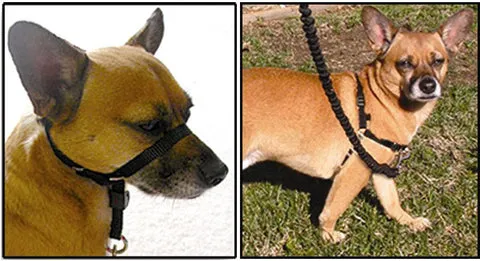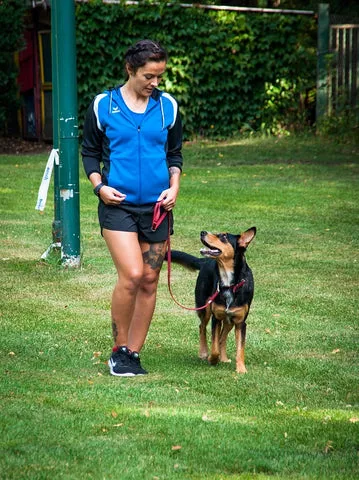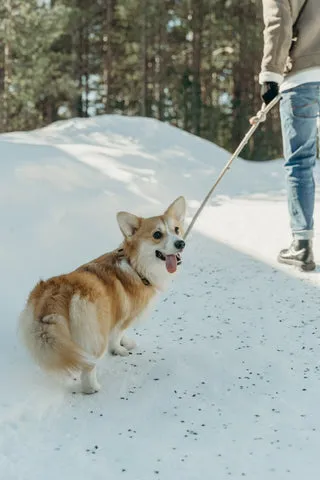Walking your dog should be a joyful experience, not a tug-of-war. Many dog owners dream of their canine companion strolling happily by their side, pausing when they stop, turning with them, and calmly ignoring distractions like other dogs and people. The good news is that teaching your dog proper leash manners is an achievable goal, although it often requires patience and consistency. While it might be one of the more challenging aspects of dog training, the effort you put into it will be well worth it, transforming your walks into a pleasant shared activity. If you’re wondering how to get my dog not to pull on leash, this guide will help you turn that vision into a reality.
Prior to Leash Training Your Puppy or Dog
Before diving into the step-by-step process, considering the right equipment can significantly aid your training. While specialized tools can help discourage pulling, dedicated leash training is essential for teaching your dog to walk politely beside you without any tension on the leash.
A front-attachment harness is generally a safe and user-friendly no-pull device suitable for most dogs. For dogs with aggressive tendencies or for owners who require maximum control, such as a smaller individual with a giant-breed dog, a head collar can be particularly effective. It’s crucial to note that both front-attachment harnesses and head collars should only be used with leashes that are a maximum of 6 feet long. Using a longer leash could allow your dog to gain too much momentum, potentially leading to injury if they abruptly reach the end of the leash.
 A small tan dog wears a head collar on the left and a front-attachment harness on the right
A small tan dog wears a head collar on the left and a front-attachment harness on the right
The “Stop and Reward” Method for Leash Training
A foundational and highly effective approach to Teach A Dog To Walk On A Leash Without Pulling is the “stop and reward” method. This simple technique involves immediately stopping your forward movement whenever your dog pulls on the leash. As soon as the leash loosens and your dog returns to your side, you reward them. Using a treat bag worn around your waist can be incredibly helpful for quick and convenient rewards during the training process. If your dog isn’t particularly motivated by food treats, you can substitute them with a favorite tug toy, chew toy, or by tossing a ball as an alternative form of positive reinforcement.
Dog Leash Training: A Step-by-Step Guide
The following steps provide a detailed roadmap on how to teach a dog to walk on a leash politely, building up their skills gradually. This comprehensive approach is designed to foster a strong understanding of desired behavior, paving the way for eventual success, and can even lay the groundwork for skills like how to train puppy to walk without leash in the future.
Step 1: Walking with My Human Is Delicious!
Begin your leash training in a familiar, low-distraction environment, such as your backyard. Attach your dog to a long rope or leash, ideally 10-20 feet long (but never a retractable leash), while they are wearing a standard harness. Prepare some highly appealing, pea-sized pieces of fresh meat or cheese to use as high-value rewards.
Decide which side you prefer your dog to walk on – the left side is the traditional choice. Whichever side you select, ensure you deliver the treat reward right by your thigh on that chosen side. This consistency helps your dog associate staying near that side with delicious rewards. Walk briskly and randomly around your yard. Whenever your dog naturally chooses to walk beside you, offer enthusiastic praise and a treat next to your preferred thigh. As they consistently walk with you, initially reward them for every step you take together. Gradually, as your dog improves, you can reduce the frequency of these rewards. If your dog shows no interest in the treats, take a break and try again later when they might be a bit hungrier. Continue practicing this step until your dog is staying reliably by your side most of the time.
Step 2: It’s Worth My While to Watch Where My Human Is Going and Go Along, Too!
For this next step in teaching a dog to walk on a leash without pulling, continue practicing in your yard. Wait for a moment when your dog is walking ahead, off to the side, or lagging behind to sniff or relieve themselves. In an upbeat voice, say “let’s go!” For the first few times, you might also slap your thigh gently to ensure your dog notices you. Immediately turn and walk away from your dog in the opposite direction.
When your dog catches up to you, reward them with praise and a treat delivered next to your preferred side. If they continue to stay with you as you walk, offer a treat every couple of steps. If your dog responds very quickly and catches up, give them an extra reward to emphasize their responsiveness.
If the leash becomes tight and your dog doesn’t move towards you, stop walking and apply gentle, steady pressure on the leash. This pressure is meant to be a subtle reminder of your presence and to make ignoring you slightly less comfortable, but it should never be used to forcibly pull your dog towards you. Praise your dog and release the pressure the moment they start to move in your direction. Once they catch up, reward them with praise and a treat by your side. Continue to provide treats every few steps if they remain with you. Practice this step until your dog consistently stays by your side and promptly returns to you after you say “let’s go” if they’ve veered off. This responsiveness is also a key component in commands like train your dog to come to you no matter what.
Step 3: I Know When It’s Time to Smell (Or to Pee On) the Roses
While teaching a dog to walk on a leash, it’s important to allow them time to explore, sniff, and relieve themselves. However, to foster better leash manners, you should decide when these opportunities occur. Approximately every 5 minutes, at a time when you would typically offer a food reward, instead say something like “go sniff!” and allow your dog to explore or go potty on the leash.
Consider this “free time” a privilege or a reward. If your dog starts pulling excessively during this period, simply say “let’s go” and immediately walk in the opposite direction, thereby ending the free time. When you’re ready to resume polite walking, clearly say “let’s go” and begin walking forward.
Step 4: Sometimes I Really Need to Pay Attention to Where My Human Is Going!
Continue practicing dog leash training in your yard using the techniques from steps one through three, but gradually transition to using a shorter leash. Eventually, aim to train with a standard 6-foot leash.
Introduce variations into your walks: practice walking extra fast, then extra slow, and frequently practice stopping and changing directions abruptly. Reward your dog if they are able to stay by your side and maintain focus during these challenging changes. As your dog becomes more proficient, you can begin to reward them less frequently for simply walking by your side in normal circumstances. However, continue to provide generous rewards when they successfully navigate these new challenges, or when they manage to stay focused and attentive despite distractions like another animal or person.
 A white dog on a leash watching its owner attentively
A white dog on a leash watching its owner attentively
Taking It to the Street: Real-World Leash Training
Once your dog has developed solid leash manners in your yard, it’s time to extend their training to real-world environments. On your neighborhood walks, you will apply the exact same techniques you mastered in your yard, but be prepared for additional distractions and challenges. Friendly strangers, tempting squirrels, and other dogs will test your dog’s focus. For these outings, consider using a front-attachment harness or head collar for enhanced control, and always bring your highest-value treats, such as fresh meat or cheese.
Say “let’s go” and begin walking. If your dog forgets their manners or starts to pull, promptly say “let’s go” and turn and walk in the opposite direction. Reward them generously with treats when they walk politely by your side. It’s particularly important to offer extra treats when it’s extra difficult for your dog to pay attention to you due to environmental distractions. Don’t forget to incorporate authorized sniff breaks as a reward, especially when teaching a how to teach your dog come command as it often requires high focus.
 A woman walking an attentive black and tan dog on a leash
A woman walking an attentive black and tan dog on a leash
Challenge Your Dog During Leash Training
To solidify your dog’s understanding of walking without pulling, introduce controlled challenges. Outfit your dog in a standard harness attached to a 6-foot leash. Hold the leash securely, and then toss a favorite ball or a high-value treat about 20 feet away from you and your leashed dog.
If your dog immediately pulls towards the object, calmly say “let’s go” and turn and walk in the opposite direction, moving away from the tempting item. If, however, your dog walks politely by your side towards the object, allow them to continue until they reach it and can take it as their reward. To make this exercise easier initially, you might start with a longer leash or use a less desirable object as the lure. This progressive challenging helps your dog understand that polite walking is the key to getting what they want.
Troubleshooting Common Leash Training Issues
Even with consistent effort, you might encounter specific challenges while teaching a dog to walk on a leash. Here’s how to address some common problems:
- Dog Crossing in Front of You: If your dog frequently cuts across your path, try stomping or shuffling your feet a bit to make your presence more obvious and encourage them to stay in their designated zone.
- Lagging Behind:
- If your dog is lagging significantly, it could be a sign that they are frightened or not feeling well. In these cases, use plenty of gentle encouragement and avoid pulling them along.
- If they are lagging to sniff or to potty, simply keep walking, applying only gentle, consistent pressure on the leash. Remember to offer frequent rewards when they return to walking with you.
- Alternating Between Walking Beside You and Pulling: If your dog seems to be alternating between polite walking and suddenly pulling, adjust your reward strategy. Stop rewarding them simply for coming back towards you after they’ve pulled. Instead, concentrate your rewards on instances where they take a larger number of consecutive steps by your side, reinforcing the sustained desired behavior.
 A small white and brown dog on a leash in the snow
A small white and brown dog on a leash in the snow
How to Teach a Dog to Walk on a Leash and Heel
Heel training is a valuable skill for specific situations where you need your dog to be very close to you and highly attentive, such as navigating crowded areas or walking past significant distractions like other animals. This command is a great foundation if you’re working towards advanced skills like how to teach your dog off leash walking.
Begin practicing the heel command in the calm environment of your home:
- Lure with a Treat: Place a high-value treat in your fist and let your dog sniff it. Say “let’s go” or “heel” and take a couple of steps, leading your dog along with the treat in your fist held near your thigh. Praise and reward your dog with the treat the moment their nose follows your fist in the correct heel position.
- Practice with Empty Fist: Once your dog understands the motion, practice having them follow your empty fist. Continue to praise and reward them for every couple of steps that they maintain the heel position, following your hand signal.
- Increase Standards and Distractions: Gradually increase your expectations with each session. Your closed fist will serve as a consistent hand signal for the “heel” command. Once proficient indoors, begin practicing outside in increasingly distracting environments, ensuring your dog can maintain focus and position.
By consistently applying these methods, you’ll be well on your way to enjoying more relaxed and fun walks with your dog.
